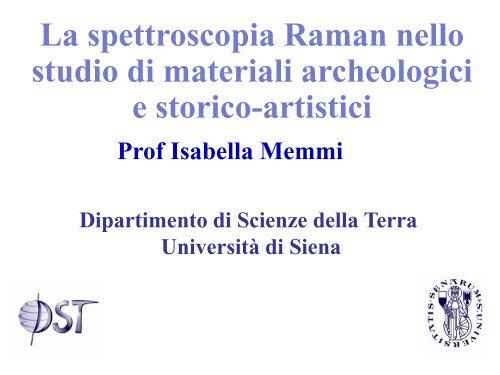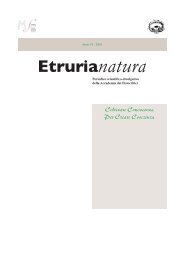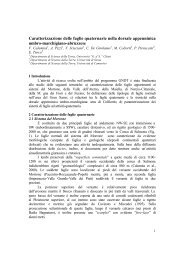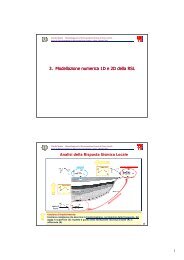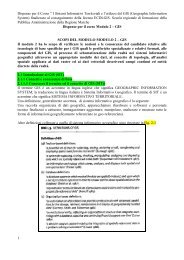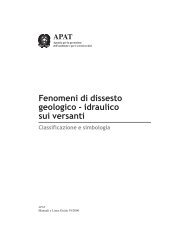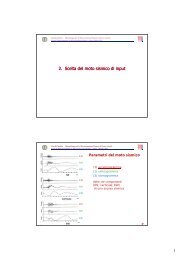Memmi - Applicazioni ai materiali archeologici - Dipartimento di ...
Memmi - Applicazioni ai materiali archeologici - Dipartimento di ...
Memmi - Applicazioni ai materiali archeologici - Dipartimento di ...
You also want an ePaper? Increase the reach of your titles
YUMPU automatically turns print PDFs into web optimized ePapers that Google loves.
La spettroscopia Raman nello<br />
stu<strong>di</strong>o <strong>di</strong> <strong>materiali</strong> <strong>archeologici</strong><br />
e storico-artistici<br />
Prof Isabella <strong>Memmi</strong><br />
<strong>Dipartimento</strong> <strong>di</strong> Scienze della Terra<br />
Università <strong>di</strong> Siena
La spettroscopia Raman<br />
1. Versatile: può analizzare <strong>materiali</strong> inorganici e organici, cristallini e non<br />
2. In grado <strong>di</strong> identificare una sostanza (specificità molecolare) con analisi<br />
puntuale grazie alla sua elevata risoluzione spaziale (fino ad 1 μm)<br />
3. poco invasiva o completamente non invasiva, può operare in situ<br />
Quin<strong>di</strong> le sue applicazioni nel campo dei Beni Culturali in continuo<br />
aumento
L’applicazione più comune e <strong>di</strong>ffusa della spettroscopia Raman<br />
nel campo dei Beni Culturali è senza dubbio lo stu<strong>di</strong>o dei<br />
<strong>materiali</strong> pittorici:<br />
1. Materiali coloranti<br />
a) Pigmenti (minerali e organici)<br />
b) Coloranti<br />
c) lacche<br />
2. Leganti<br />
Ma ci sono anche altre applicazioni su <strong>materiali</strong> organici e<br />
inorganici fra cui:<br />
1. Ambre e resine fossili<br />
2. Pergamene, avorio<br />
3. Materiali lapidei<br />
4. Prodotti <strong>di</strong> corrosione dei metalli<br />
5. Minerali e gemme<br />
6. Ceramiche<br />
7. Vetri e paste vitree
Aumentati negli ultimi anni i lavori con Raman su BC così<br />
come sono aumentati i lavori su BC<br />
Vandenabeele et al, 2007
Tipi <strong>di</strong> laser <strong>di</strong>versi in<br />
funzione del materiale<br />
e dell’anno<br />
Prevalentemente NIR<br />
per <strong>materiali</strong> organici<br />
Da rossi a NIR per<br />
pigmenti<br />
Prevalentemente ver<strong>di</strong> per<br />
vetri e ceramiche e per<br />
prodotti <strong>di</strong> corrosione<br />
Vandenabeele et al, 2004
1. AMBRE E RESINE FOSSILI<br />
L’ambra è la resina fossilizzata del pinus succinifera e<br />
viene raccolta principalmente sulle spiagge del mar<br />
Baltico. Le resine non provenienti dal mar Baltico<br />
vengono dette genericamente resine fossili.<br />
L’ambra è la più dura resina conosciuta<br />
e può essere <strong>di</strong>spersa nell’olio per<br />
ottenerne una vernice. Contiene acido<br />
succinico e zolfo fino all’1%.<br />
Acido succinico
Le ambre e le resine fossili sono <strong>di</strong>stinguibili dalle resine non maturate grazie<br />
alle seguenti caratteristiche:<br />
1) Assenza della banda a 3020 cm -1 relativa alla presenza del gruppo –C=CH-<br />
1) Minore intensità della banda a 2850 cm -1 dovuta alla <strong>di</strong>minuzione del<br />
contenuto in –CH 3<br />
2) Assenza delle bande a 1612, 760, 740, 713 cm -1<br />
3) Minore rapporto dell’intensità relativa del picco a 1646 cm -1 ( ν (C=C) )<br />
rispetto a quello a 1450 cm -1 ( δ (CH 2 ) ) dovuto al progressivo deterioramento<br />
del legame ν (C=C) (il valore <strong>di</strong> questo rapporto è 1.7 per le resine <strong>di</strong> pino non<br />
maturate, 1.0 per le copali, 0.5-0.6 per le ambre).<br />
Interessante è il metodo <strong>di</strong> datazione delle ambre e delle resine fossili,<br />
proposto a più riprese [Shen et al. 1997, Winkler et al. 1998, Winkler et al.<br />
2001, Brody et al. 2001], che si basa sulla correlazione tra l’età della resina<br />
e l’intensità del rapporto ( 1640/1440 cm -1 )
Lo stu<strong>di</strong>o Raman su ambre <strong>di</strong> <strong>di</strong>versa provenienza geografica non ha dato invece<br />
chiare in<strong>di</strong>cazioni (Brody et al, 2001). Le <strong>di</strong>fferenze dovute più a <strong>di</strong>versa maturazione<br />
(picco a 3020 assente nelle più vecchie). Nella zona 1646 and 1450 cm-1, più o meno<br />
uguali ma <strong>di</strong>verse intensità<br />
Fig. 2.<br />
Stack plot of FT-Raman spectra in the wavenumber regions 3200–2600 cm −1 and<br />
1800–200 cm −1 of (A) kauri resin (A.australis), (B) fossil resin from North Germany<br />
and (C) fossil resin from the east coast of England.
2. Pergamene e avorio<br />
Negli spettri riportati è mostrata la possibilità (?) <strong>di</strong> <strong>di</strong>stinguere avorio<br />
e pergamena provenienti da animali <strong>di</strong>versi
3. Materiali lapidei<br />
Nel caso delle asce preistoriche, materiale che non può essere manipolato, in<br />
genere chimica con PIXE (Particle Induced X-ray Emission) tecnica non<br />
<strong>di</strong>struttiva, molto sensibile ma necessario acceleratore <strong>di</strong> particelle (protoni)<br />
Stu<strong>di</strong> <strong>di</strong> provenienza per stabilire circolazione manufatti in antichità.<br />
Spesso <strong>di</strong>fficile riconoscere la materia prima, per esempio nel caso delle<br />
asce realizzate con ‚rocce ver<strong>di</strong>‛ (giadeiti, eclogiti, anfiboliti, scisti?)<br />
Stu<strong>di</strong>o Raman su due asce pre-colombiane in rocce ver<strong>di</strong>, senza sezione<br />
sottile, consentito <strong>di</strong> riconoscere che una fabbricata con eclogite e l’altra <strong>di</strong><br />
giada a giadeite <strong>di</strong> composizione unica al mondo. Smith D. and Gendron<br />
(1997)
Raman portatile con microscopio orizzontale per analizzare il<br />
teschio Azteco ricavato da un unico cristallo <strong>di</strong> quarzo ialino<br />
o cristallo <strong>di</strong> rocca. Spettro Raman confermato quarzo α
4. Patine <strong>di</strong> corrosione <strong>di</strong> metalli<br />
Lavoro effettuato su campioni artificiali simulanti<br />
monete romane o puniche. Stu<strong>di</strong>o Raman in grado<br />
<strong>di</strong> <strong>di</strong>scriminare i <strong>di</strong>versi cloruri <strong>di</strong> rame e altri<br />
minerali dovuti al seppellimento (calcite, ematite)<br />
Cu 2(OH) 3Cl<br />
Bertolotti et al, 2011
Corrosion of ancient (25-220 AD) chinese bronze<br />
Money Trees Stu<strong>di</strong>ed by Raman Microscopy McCann<br />
et al, 1999<br />
Fra i minerali determinati: cuprite (Cu 2O), tenorite (CuO),<br />
malachite [CuCO 3 . Cu(OH)2] , azzurrite [2CuCO 3 . Cu(OH)2],<br />
litargirio (PbO), PbCO 3, PbSO 4 .<br />
Sono stati anche in<strong>di</strong>viduati alcuni pigmenti all’esterno applicati<br />
in epoca recente fra cui: blu oltremare (lapis lazuli), blu <strong>di</strong><br />
Prussia Fe 4[Fe(CN) 6] 3, giallo cromo (PbCrO 4)<br />
Figure 3. Raman spectra of Cu compounds found in the money tree cross-sections.<br />
In each plot, the top curve is the spectrum from the artifact and the bottom curve is<br />
the spectrum from a standard sample. (a) malachite; (b) cuprite; (c) azurite (d)<br />
tenorite.
Figure 4. Raman spectra of Pb compounds found in the money tree cross-sections. In each<br />
plot, the top curve is the spectrum from the artifact and the bottom curve is the spectrum<br />
from a standard sample. (a) PbCO 3; (b) orthorhombic PbO; (c) PbSO 4; (d) tetragonal PbO<br />
(with no standard spectrum shown).
5. Minerali e gemme<br />
Ovviamente minerali appartenenti a collezioni museali e<br />
gemme in gioielli <strong>di</strong> interesse storico artistico<br />
Interessante lo stu<strong>di</strong>o <strong>di</strong> provenienza (Calligaro et al., 2002) su granati in<br />
gioielli francesi del periodo Merovingio (V-VII secolo). Composizione<br />
chimica con PIXE: due gruppi: a)alman<strong>di</strong>no; b) piropo.<br />
Stu<strong>di</strong>o Raman inclusioni minerali: nell’alman<strong>di</strong>no due gruppi con<br />
inclusioni <strong>di</strong>verse. Piropo senza inclusioni. Dal confronto con databases<br />
probabile provenienza da Europa dell’est e forse Asia<br />
Stu<strong>di</strong> su gioielli antichi per stabilire se pietre vere o false<br />
Stu<strong>di</strong>o con strumentazioni portatili, fra cui Raman su Tesoro <strong>di</strong><br />
S.Nicola <strong>di</strong> Bari e Madonna Odegitria (E. Scandale,<br />
<strong>Dipartimento</strong> Geomineralogico, Università <strong>di</strong> Bari)
Madonna Odegitria <strong>di</strong> Bari<br />
Mappa delle gemme
Tipologia delle gemme<br />
31<br />
granato piropo<br />
69<br />
47<br />
Inclusioni ilmenite<br />
Doppietto alman<strong>di</strong>no – pasta vitrea<br />
quarzo – pasta vitrea<br />
collante colorato<br />
69
Quarzo citrino e<br />
doppiette granato- pasta vitrea<br />
quarzo granato
Reliquiario <strong>di</strong><br />
San Sebastiano, XIII secolo<br />
granato<br />
Castone alterato per ospitare gemma più<br />
piccola dell’originale
Reliquiario <strong>di</strong> San Gregorio Magno, sec. XVI<br />
Advanced Research and Characterization of Ornamental and GEmmological Materials<br />
Doppietto<br />
<strong>di</strong> quarzo<br />
Spettro<br />
Raman
6. Ceramiche, smalti e vetrine<br />
Raman utilizzata per determinare i pigmenti visivamente simili, ma in realtà<br />
<strong>di</strong>versi in composizione da luogo a luogo (ematite pura, litargirio puro o<br />
miscele dei due) in ceramiche me<strong>di</strong>evali Italia meri<strong>di</strong>onale (Clark , Curri e<br />
Laganara, 1997)<br />
Su un frammento <strong>di</strong> ceramica <strong>di</strong> scarsa qualità <strong>di</strong> un bel colore blu stessa<br />
località) trovato lapis lazuli. Assolutamente strano ad<strong>di</strong>rittura unico.<br />
In una ceramica cinese (circa 3000 aC), me<strong>di</strong>ante Raman, determinato uso<br />
<strong>di</strong> anatasio per il rivestimento. Primo ritrovamento in assoluto <strong>di</strong> questo<br />
pigmento naturale. Solo negli anni ‘20 del secolo scorso iniziato l’uso <strong>di</strong><br />
anatasio ma sintetico. Ceramica evidentemente cotta a bassa<br />
temperatura: infatti fra 800 e 1000°C trasformazione in rutilo (Zuo et al.,<br />
1999)<br />
Spettri Raman possono essere usati per <strong>di</strong>stinguere la porcellana softpaste<br />
da quella hard-paste. Infatti nella prima troviamo -wollastonite<br />
e/o tricalcio fosfato (-Ca 3(PO4) 2), nella seconda mullite.
Fabbri et al 2008<br />
The study of the Capo<strong>di</strong>monte<br />
production: an occasion for the<br />
proposal of a Raman database<br />
for ancient porcel<strong>ai</strong>ns<br />
Figure 1 - Some of the analyzed<br />
excavation samples (P173, P182, P192)<br />
and museum objects (MNC4423,<br />
MNC13534, MNC25343). Images are<br />
not to scale
Schema <strong>di</strong> protocollo sperimentale per analisi Raman <strong>di</strong> porcellane
Figura 2 – Representative Raman spectra of Capo<strong>di</strong>monte pastes (left)<br />
and glazes (right). Cr=cristobalite; Tr=try<strong>di</strong>mite; β-w= β-wollastonite
Sienese arch<strong>ai</strong>c m<strong>ai</strong>olica: a<br />
technological study of the<br />
ceramic bo<strong>di</strong>es and coatings<br />
FORTINA C., SANTAGOSTINO BARBONE A.,<br />
MEMMI TURBANTI I
M<strong>ai</strong>olica arc<strong>ai</strong>ca senese<br />
(XIV secolo)<br />
3) Scarti<br />
tecnologici<br />
Rivestimenti: 3 gruppi in base all’aspetto<br />
estetico<br />
2) Scarti <strong>di</strong><br />
dubbia origine<br />
1) Scarti post<br />
cottura
SEM:<br />
Tessiture<br />
smalti<br />
SCARTI DI<br />
DUBBIA<br />
ORIGINE<br />
SCARTI<br />
POST COTTURA<br />
SCARTI<br />
TECNOLOGICI
SEM-EDS: fasi <strong>di</strong> neoformazione<br />
Smalti<br />
Ca-Mg piroxene<br />
Quarzo?<br />
Microspettroscopia<br />
Raman
7. Vetri e paste vitree<br />
Inizialmente non molti lavori sia per il debole Raman scattering che per la<br />
fluorescenza. Ora fluorescenza utilizzata. Infatti il rapporto <strong>di</strong> intensità fra<br />
il picco a 1080 cm -1 e la banda <strong>di</strong> fluorescenza centrata a circa 2000 cm -1<br />
manufatto<br />
Diversi stu<strong>di</strong> su fenomeni <strong>di</strong> alterazione del vetro anche con risultati<br />
imprevisti. Vetro so<strong>di</strong>co in genere più durevole <strong>di</strong> quello potassico. Ma<br />
talvolta eccezioni e vetro potassico più resistente (Bertoncello et al, 2002).<br />
Probabilmente da considerare influenza dell’ambiente <strong>di</strong> seppellimento<br />
Interessante indagine non <strong>di</strong>struttiva con Raman portatile<br />
su oggetti in vetro policromo e decorato <strong>di</strong> varie epoche<br />
(Ricciar<strong>di</strong> et al, 2008) provenienti dal Museo Nazionale della<br />
ceramica <strong>di</strong> Sèvres
Figure 2. (a) MNC2793, Venice, circa 1500 (h = 39 cm); (b) R1476,<br />
Venice, circa 1480–1500, prior Salomon de Rothschild collection (h =<br />
30 cm); (c) MNC vase, Orl èans or Nevers, 18th century (h = 20 cm);<br />
(d) R1473, Venice, circa 1500, prior Salomon de Rothschild collection<br />
(Ø = 27 cm); (e) R1475, Italy, 19th century, prior Salomon de<br />
Rothschild collection (h ∼8 cm); (f) MNC28009, Venice, 16th century<br />
(h = 11.3 cm); (g) MNC27961, ‘Fac¸on de Venise’, Holland, 16th–17th<br />
century (h = 13.6 cm). All artefacts from the Musée National de<br />
Céramique (Sèvres).<br />
Lo stu<strong>di</strong>o Raman ha consentito <strong>di</strong><br />
<strong>di</strong>stinguere i vetri usati per il body<br />
in due gruppi: mixed Ca-Na (545 e<br />
1100 cm -1 ) e Ca-richNa-based (550-<br />
545 e 1100 cm -1 ) Alcune eccezioni<br />
con K (496 e 1053 cm -1 )<br />
La maggior parte degli smalti sono<br />
lead-based (970 cm -1 )tranne alcuni<br />
che hanno composizione simile a<br />
quella della massa vitrea.<br />
I pigmenti sono simili a quelli usati<br />
per le ceramiche
Ca-rich Na-based<br />
Mixed Ca-Na<br />
Cassiterite<br />
635-775 cm -1<br />
Lead-based glass<br />
970 cm -1<br />
Bindheimite<br />
Pb 2Sb 2O 7 135-325 cm -1<br />
più Co o Cu matrice<br />
-hematite<br />
220, 295….1310<br />
Ca-rich Na-based<br />
Vetro contenente K<br />
Non solo tipi <strong>di</strong>versi <strong>di</strong><br />
impasti per i corpi, ma<br />
anche per i <strong>di</strong>versi<br />
smalti<br />
Lead-based nel verde<br />
(970 cm -1 )<br />
Lead-Na silica glass nel<br />
rosso (1055 cm -1 )
Tipi <strong>di</strong> Materiali Coloranti<br />
I <strong>materiali</strong> coloranti possono essere sud<strong>di</strong>visi in base alle loro<br />
caratteristiche fisiche in:<br />
Pigmenti: sostanze generalmente inorganiche (minerali o rocce), talvolta<br />
organiche (carbone), aventi proprietà coprenti, insolubili nel mezzo<br />
<strong>di</strong>sperdente col quale formano un impasto più o meno denso. Sono dotati<br />
<strong>di</strong> colore e <strong>di</strong> corpo; impartiscono il proprio colore aderendo me<strong>di</strong>ante un<br />
legante alla superficie del mezzo che si desidera colorare. Possono essere<br />
naturali o artificiali.<br />
Coloranti: sostanze generalmente organiche (animali, vegetali) trasparenti,<br />
solubili nel mezzo <strong>di</strong>sperdente. Sono dotati <strong>di</strong> colore ma non <strong>di</strong> corpo;<br />
impartiscono il proprio colore per inclusione, assorbimento o legame<br />
chimico con il mezzo che si desidera colorare. (Indaco, Porpora).<br />
Lacche: coloranti solubili in acqua, intrappolati in un substrato solido come<br />
calcare o argilla, precipitati e successivamente polverizzati, da utilizzare<br />
analogamente <strong>ai</strong> pigmenti, (Robbia, Cocciniglia).<br />
Generalmente non si adotta questo tipo <strong>di</strong> sud<strong>di</strong>visione ma la semplice<br />
classificazione in : Pigmenti Inorganici e Pigmenti Organici, a loro volta<br />
sud<strong>di</strong>visi in naturali o artificiali
Le principali tecniche per la preparazione dei pigmenti<br />
sono:<br />
la macinazione <strong>di</strong> minerali o rocce<br />
la calcinazione: processo <strong>di</strong> riscaldamento ad alta<br />
temperatura, protratto per il tempo necessario ad<br />
eliminare tutte le sostanze volatili dal composto<br />
la cottura <strong>di</strong> sostanze animali o vegetali<br />
i processi <strong>di</strong> sintesi<br />
Tipi <strong>di</strong> Materiali Coloranti
Leganti<br />
Composti a base <strong>di</strong> proteine:<br />
albumina, caseina, colle animali<br />
Composti a base <strong>di</strong> polisaccari<strong>di</strong>:<br />
amido e gomme<br />
Composti a base <strong>di</strong> aci<strong>di</strong> grassi (cere):<br />
cera d’api, cera <strong>di</strong> carnauba, cera montana<br />
Resine: Sangue <strong>di</strong> Drago, Gomma Gutta
Spettri Raman <strong>di</strong> leganti proteici:<br />
a)Albumina<br />
b)Caseina<br />
c) Gelatina<br />
d)Colla da storione<br />
e)Colla <strong>di</strong> pesce
Spettri Raman <strong>di</strong> polisaccari<strong>di</strong>:<br />
a) Amido; b) Gomma arabica; c) Tragacanth (legumi); d) Gomma <strong>di</strong><br />
ciliegio
Spettri Raman <strong>di</strong> resine:<br />
a) Trementina <strong>di</strong> Venezia<br />
b) Trementina <strong>di</strong> Strasburgo<br />
c) Ambra<br />
d) Mastice<br />
e) Sangue <strong>di</strong> Drago<br />
f) Gambogia
Caratterizzazione<br />
Pigmenti<br />
caratterizzazione della tavolozza <strong>di</strong> un artista<br />
capacità tecnologiche e provenienza<br />
Conservazione e Restauro<br />
stu<strong>di</strong>o degli effetti degli agenti <strong>di</strong> alterazione sui pigmenti<br />
ripristino <strong>di</strong> aree rovinate o mancanti utilizzando pigmenti simili<br />
Datazione e autenticazione<br />
in base alla collocazione temporale dei pigmenti identificati
I Pigmenti della Preistoria<br />
Nelle civiltà primitive si utilizzavano solo pochi colori:<br />
Rosso: Giallo:<br />
Ocre Rosse Naturali: ematite<br />
(Fe 2O 3), magnetite (Fe 3O 4)<br />
+ silicati argillosi<br />
Bruno:<br />
Nero: MnO 2<br />
Carbone<br />
Ocre Gialle Naturali: goetite<br />
((FeO(OH)), limonite (2Fe 2O 33H 2O)<br />
+ silicati argillosi<br />
Terre d’Ombra Naturali:<br />
FeO(OH)+MnO 2 + silicati + carbonati<br />
Bianco: Calce (CaO)<br />
Calcari, Marmi e Travertini (CaCO 3)
I Pigmenti della Preistoria<br />
I pigmenti aderivano alle pareti delle rocce perché:<br />
erano intrappolati dalla porosità della superficie<br />
il legante ne permetteva l’adesione: acqua, oli vegetali,saliva, urina,<br />
grassi animali, midollo osseo, sangue e albume<br />
Grotte <strong>di</strong> Lascaux (Francia)<br />
Grotte <strong>di</strong> Altamira (Spagna)<br />
Le ochre costituivano la tavolozza <strong>di</strong> base degli artigiani preistorici
I Pigmenti delle Civiltà del Me<strong>di</strong>terraneo<br />
Il sorgere <strong>di</strong> civiltà nell’area me<strong>di</strong>terranea creò le basi per<br />
l’utilizzo <strong>di</strong> molti altri colori:<br />
Rosso : Cinabro (HgS), Minio (Pb 3O 4), Realgar (AsS)<br />
Giallo : Orpimento (As 2S 3), Litargirio (PbO)<br />
Bianco :<br />
Gesso (CaSO 4.2H 2O)<br />
Crete (calcaree: CaCO 3; silicee: SiO 2)<br />
Bianco <strong>di</strong> Ossido <strong>di</strong> Piombo (2PbCO 3 Pb(OH) 2)<br />
Nero :<br />
Nero Fumo<br />
Nero <strong>di</strong> Avorio<br />
Nero <strong>di</strong> Vite<br />
cerussite
I Pigmenti delle Civiltà del Me<strong>di</strong>terraneo<br />
Verde : Verderame<br />
(Cu (CH 3COO) 2 H 2O)<br />
Malachite<br />
(Cu 2CO 3(OH) 2)<br />
Terra Verde<br />
glauconite<br />
Guado<br />
Indaco<br />
Pigmenti Organici<br />
Kermes<br />
celadonite<br />
Garanza<br />
Blu : Azzurrite (2CuCO 3 Cu(OH) 2)<br />
Blu Oltremare<br />
Na8-10Al6Si6O24S2-4) lazurite<br />
lapislazzuli<br />
Blu Egizio (CaCuSi 4O 10)<br />
Porpora<br />
Giallo <strong>di</strong> Spincervino<br />
Zafferano
Stu<strong>di</strong>o degli inchiostri usati per manoscritti illuminati<br />
Per queste opere spesso utilizzati gli inchiostri, costituiti da pigmenti o coloranti<br />
combinati ad un legante e <strong>di</strong>spersi in un mezzo veicolante, generalmente acqua.<br />
Preferiti pigmenti inorganici, perché più stabili nel tempo, rispetto a organici, più<br />
facilmente soggetti a degradazione fotochimica. Spesso utilizzato anche l’oro sotto<br />
forma <strong>di</strong> <strong>di</strong>spersione.
Spettri Raman dalla Paris Bible (1270)<br />
I pigmenti identificati sono otto: Azzurrite,<br />
Lapislazzuli (per gli sfon<strong>di</strong> <strong>di</strong> quattro scene),<br />
Bianco Piombo, Cinabro, Orpimento e Rosso<br />
Piombo (per le cornici gialle e arancioni e per<br />
la tunica <strong>di</strong> Dio nella quarta e settima scena),<br />
Realgar, Malachite, questi ultimi due<br />
probabilmente presenti come impurezze o<br />
prodotti <strong>di</strong> degradazione <strong>di</strong> orpimento e<br />
azzurrite
Pigments and plasters <strong>di</strong>scovered in the House of<br />
Diana (Cosa, Grosseto-Italy): an integrated study<br />
between Art History, Archaeology and scientific<br />
analyses.<br />
DAMIANI, D., GLIOZZO,<br />
E.,TURBANTI MEMMI, I. &<br />
SPANGENBERG, J.
Trento<br />
Casa <strong>di</strong> Diana<br />
Palatino<br />
Caso <strong>di</strong> Stu<strong>di</strong>o - Raman<br />
Villa Romana<br />
<strong>di</strong> Isera<br />
Cosa (Grosseto)<br />
Roma<br />
Fase identificata: cinabro<br />
Pigmento: Rosso <strong>di</strong> Cinabro<br />
(Minium Cinnabaris)<br />
intensity<br />
Casa <strong>di</strong><br />
Diana<br />
Villa <strong>di</strong> Isera<br />
Palatino<br />
0 200 400 600 800 1000 1200 1400 1600<br />
wavenumber / cm -1<br />
Laser Line: 514.5 nm<br />
Power: 5 mW
Casa <strong>di</strong> Diana<br />
Intensity<br />
Fase identificata: Ematite<br />
Pigmento: Ocra Rossa<br />
(Riubrica)<br />
Caso <strong>di</strong> Stu<strong>di</strong>o - Raman<br />
Villa <strong>di</strong> Isera Palatino<br />
100 300 500 700 900 1100 1300 1500<br />
Wavenumber / cm-1<br />
intensity<br />
Fase identificata: Goetite<br />
Pigmento: Ocra Gialla<br />
(Sil)<br />
0 200 400 600 800 1000 1200 1400 1600<br />
wavenumber / cm -1<br />
Casa <strong>di</strong> Diana Villa <strong>di</strong> Isera Palatino
Casa <strong>di</strong> Diana<br />
Intensity<br />
Caso <strong>di</strong> Stu<strong>di</strong>o - Raman<br />
Villa <strong>di</strong> Isera Palatino 0 200 400 600 800 1000 1200 1400 1600 1800<br />
100 300 500 700 900 1100 1300 1500<br />
Wavenumber / cm-1<br />
Fase identificata: Cuproriv<strong>ai</strong>te<br />
Pigmento: Blu Egizio<br />
(Caeruleum)<br />
intensity<br />
intensity<br />
calcite<br />
wavenumebr cm-1<br />
quarzo<br />
0 200 400 600 800 1000 1200 1400 1600 1800<br />
wavenumebr cm-1
intensity<br />
100 200 300 400 500 600 700 800 900 1000<br />
Wavenumber / cm-1<br />
Caso <strong>di</strong> Stu<strong>di</strong>o - Raman<br />
Casa <strong>di</strong> Diana Villa <strong>di</strong> Isera Palatino<br />
Fase identificata: Celadonite<br />
Pigmento: Terra Verde<br />
(Creta Viri<strong>di</strong>s)<br />
Celadonite (Monte Baldo)<br />
Intensity<br />
0 200 400 600 800 1000 1200 1400 1600<br />
Wavenumber / cm-1<br />
Fase identificata: Malachite<br />
Pigmento: Malachite
Intensity<br />
intensity<br />
Caso <strong>di</strong> Stu<strong>di</strong>o - Raman<br />
100 300 500 700 900 1100 1300 1500<br />
Wavenumber / cm-1<br />
0 500 1000 1500<br />
wavenumber / cm-1<br />
Fase identificata: Calcite<br />
Pigmento: Bianco <strong>di</strong> Calce<br />
(Creta)<br />
Fase identificata: Carbone<br />
Pigmento: Nero <strong>di</strong> Carbone<br />
(Atramentum)
Caso <strong>di</strong> Stu<strong>di</strong>o - Raman<br />
GRIGIO<br />
Blu Egizio<br />
Nero <strong>di</strong> Carbone<br />
Terra Verde<br />
MARRONE<br />
Ocra Gialla<br />
Blu Egizio<br />
Ocra Rossa<br />
VIOLA<br />
Blu Egizio<br />
Nero <strong>di</strong> Carbone<br />
Ocra Rossa
cuproriv<strong>ai</strong>te<br />
Due tipi <strong>di</strong> Blu Egizio:<br />
Caso <strong>di</strong> Stu<strong>di</strong>o - SEM<br />
1<br />
1 – <strong>di</strong> migliore qualità,<br />
prodotto secondo la ricetta<br />
originaria<br />
quarzo+calcite+malachite<br />
(Room C)<br />
2 – <strong>di</strong> peggiore qualità,<br />
prodotto riutilizzando<br />
oggetti in bronzo (aree<br />
grigie)<br />
Garden<br />
Portico<br />
Impluvium<br />
1<br />
2<br />
2<br />
2<br />
Cu<br />
Sn<br />
Casa <strong>di</strong> Diana<br />
Cosa (GR)<br />
cuproriv<strong>ai</strong>te<br />
cuproriv<strong>ai</strong>te<br />
2
Almaden<br />
Caso <strong>di</strong> Stu<strong>di</strong>o - Analisi Isotopiche<br />
Casa <strong>di</strong> Diana<br />
La composizione isotopica del Rosso <strong>di</strong><br />
Cinabro <strong>di</strong> alcuni campioni è stata<br />
paragonata con i valori isotopici del cinabro<br />
presente in alcuni giacimenti europei<br />
Valore me<strong>di</strong>o per Cosa 11.8 ± 0.2‰<br />
Quin<strong>di</strong> simile a Almaden e Idrija<br />
Nessun giacimento superficiale a Idrija e<br />
estrazione sotterranea iniziata solo nel<br />
1590<br />
La Mure<br />
Monte Amiata<br />
Idrija<br />
Cinabro<br />
Casa <strong>di</strong> Diana<br />
Room A<br />
(Spagna) Almadén<br />
(Slovenia) Idrija<br />
(Italia) Monte Amiata<br />
(Francia) Genepy<br />
(Germania) Moschellandsberg<br />
Laurion<br />
Efeso<br />
Sample 6<br />
Sample 13<br />
Sample 38<br />
δ 34 S<br />
(‰,CDT)<br />
11.6 ± 0.3 (n=2)<br />
11.8 ± 0.2 (n=2)<br />
12.1 ± 0.3 (n=3)<br />
-11.8 to 8.8 (5.6)<br />
-0.9 to 9.1 (4.6)<br />
-7.6 to 2.4 (-0.3)<br />
-3.5 to 2.2 (-2.8)<br />
-19.6 to 3.4 (-15.6)<br />
Quin<strong>di</strong> cinabro<br />
<strong>di</strong> Cosa<br />
proveniente da<br />
Almaden
The colours of frescoes in the Church<br />
Sant’Agostino a Siena: charcaterization of the<br />
p<strong>ai</strong>nting materials and evaluation of the state<br />
of conservation<br />
D. Damiani e I. <strong>Memmi</strong><br />
Turbanti<br />
<strong>Dipartimento</strong> <strong>di</strong> Scienze della<br />
Terra<br />
Università <strong>di</strong> Siena
The stu<strong>di</strong>ed frescoes<br />
included the ‚Maestà‛<br />
by Ambrogio Lorenzetti<br />
(a, 1335-1338), and the<br />
‚Nascita della Vergine‛<br />
and ‚Natività <strong>di</strong> Cristo‛<br />
by Francesco <strong>di</strong> Giorgio<br />
Martini (b and c, 1490-<br />
1494)
Fig. 2. Schematic map of the S. Agostino a Siena church<br />
The “Maestà” was p<strong>ai</strong>nted in the “Cappella<br />
Piccolomini”. In the 1596 the fresco was partly<br />
hidden by the buil<strong>di</strong>ng of a marble altar. In the 1604<br />
the “Adorazione dei Magi”, p<strong>ai</strong>nted by Sodoma,<br />
was put on the altar and the fresco was definitely<br />
hidden. In the 1944, when the Sodoma p<strong>ai</strong>nting was<br />
moved for security reasons, the Lorenzetti fresco<br />
come to light ag<strong>ai</strong>n.<br />
The frescoes by Francesco <strong>di</strong><br />
Giorgio Martini, monochrome<br />
with grey tonalities, were<br />
p<strong>ai</strong>nted in the Cappella Bichi.<br />
Only recently (1977) they were<br />
re-<strong>di</strong>scovered under the plaster<br />
(due to the Vanvitelli’s<br />
restoration)
Aim of the study was to acquire det<strong>ai</strong>led information about the<br />
materials (pigments and plasters), the p<strong>ai</strong>nting techniques and the<br />
conservation state<br />
Experimental methods<br />
About 300 samples (mostly smaller than 1 mm) were collected from the<br />
frescoes by soft brush and lancet on the basis of:<br />
1) Colour of the pigments<br />
2) Macroscopic features of plaster layers<br />
3) State of conservation<br />
Micro-Raman spectroscopy was used for pigment identification<br />
Optical Microscopy observations and SEM-EDS analyses were<br />
performed to characterize pigments, plasters and alteration products
The obt<strong>ai</strong>ned results allowed to reconstruct the Lorenzetti’s palette of colours:<br />
Yellow ochre, burnt Sienna, red ochre, cinnabar, red lead, azurite, green earth,<br />
ver<strong>di</strong>gris, chalk, lead white and carbon black. Their combination produced a wider<br />
range of chromatic shades.
Summary of the chromatic shades occurring in the ‚Maestà‛
STATE OF CONSERVATION<br />
The pigment result well preserved. Only azurite presents limited<br />
chromatic alteration phenomena due to the following transformation<br />
1. Azurite clinoatacamite<br />
2. Azurite malachite<br />
3. Azurite tenorite<br />
1. Clinoatacamite<br />
Cu 2(OH) 3Cl<br />
2. Malachite<br />
Cu 2CO 3(OH) 2<br />
3. Tenorite<br />
CuO<br />
Clin<br />
Mal<br />
Ten
Physico-chemical processes have produced evident salt crystallization phenomena<br />
(m<strong>ai</strong>nly gypsum and oxalates, with minor chlorides and nitrates).<br />
These processes caused: a) whitening of the p<strong>ai</strong>nt film due to gypsum<br />
formation; b) dark patinas on the p<strong>ai</strong>nt film m<strong>ai</strong>nly due to the formation<br />
of oxalate layers inclu<strong>di</strong>ng carbon and dust particles; c) detachments of<br />
the p<strong>ai</strong>nt film and the intonachino layer; d) pulverization of the<br />
pigments
The Francesco <strong>di</strong> Giorgio Martini monochromes<br />
The basic grey shade was obt<strong>ai</strong>ned by small gr<strong>ai</strong>ns of yellow ochre, carbon<br />
black and green earth <strong>di</strong>spersed in the whitewash matrix<br />
The chiaroscuro was obt<strong>ai</strong>ned<br />
by mixing, in <strong>di</strong>fferent<br />
proportions, whitewash and<br />
carbon black
Conservazione e Restauro<br />
Nel settore dello stu<strong>di</strong>o delle superfici pittoriche, molto importante è la<br />
determinazione dei composti chimici che formano un pigmento in quanto, alla<br />
luce <strong>di</strong> un intervento restaurativo, è opportuno sapere quali composti usare per<br />
operare in maniera più indolore e più conforme alle caratteristiche dell’opera in<br />
esame.<br />
L’analisi chimica può fornire informazioni utili sullo stato <strong>di</strong> degrado <strong>di</strong> un<br />
reperto, rendendo così possibili interventi mirati <strong>di</strong> restauro. Si tratta <strong>di</strong><br />
determinare la composizione chimica <strong>di</strong>:<br />
depositi salini<br />
incrostazioni<br />
efflorescenze<br />
alterazioni <strong>di</strong> pigmenti e leganti<br />
in definitiva mo<strong>di</strong>ficazioni dannose delle superfici, per scoprire la natura chimica<br />
del deca<strong>di</strong>mento e, ove possibile, suggerire i rime<strong>di</strong> proponendo i mezzi più<br />
opportuni per rimuovere le impurità.
Stu<strong>di</strong> <strong>di</strong> degradazione<br />
Spettroscopia Raman<br />
Nella figura è riportata un'immagine da un foglio <strong>di</strong> un evangelario bizantino del<br />
XIII secolo: in alcuni volti dei personaggi compare la tinta rosa, ottenuta<br />
miscelando i pigmenti Cinabro (rosso) e Bianco piombo (bianco); in altri il<br />
colore rosa è stato sostituito da un colore scuro, dovuto al solfuro <strong>di</strong> piombo<br />
nero che si forma per alterazione del Bianco piombo.<br />
Bianco piombo Galena<br />
2PbCO 3·Pb(OH) 2 + H 2S PbS
Autenticazione<br />
Le contraffazioni <strong>di</strong> opere d’arte sono, come è noto, molto comuni. Le tecniche<br />
della chimica analitica possono essere utilizzate per verificare l’autenticità <strong>di</strong><br />
un reperto:<br />
In<strong>di</strong>viduazione in un quadro <strong>di</strong> pigmenti che non sono compatibili con la<br />
sua attribuzione temporale<br />
Siccome è noto il periodo <strong>di</strong> impiego dei vari pigmenti usati nel corso della<br />
storia dell’arte, risulta evidente che non è possibile ritrovare un pigmento<br />
creato in epoca moderna in un quadro attribuibile a epoche meno recenti. Ad<br />
esempio, il pigmento denominato Bianco Piombo è stato utilizzato come<br />
bianco fin da prima del 1300; il pigmento Bianco Titanio, invece, è entrato<br />
in uso dal XIX secolo e quin<strong>di</strong>, a <strong>di</strong>fferenza del precedente, non può essere<br />
presente in opere pittoriche antecedenti a questa epoca (tranne eccezione<br />
vista per ceramica cinese)<br />
Alcuni pigmenti sono stati utilizzati in un intervallo <strong>di</strong> tempo ben definito e sono<br />
quin<strong>di</strong> dei veri e propri marcatori temporali.
Lista dei pigmenti ante 1400<br />
Inizio<br />
utilizzo<br />
Pigmento<br />
Fine<br />
utilizzo<br />
Inizio<br />
utilizzo<br />
Pigmento<br />
Fine<br />
utilizzo<br />
< 1300 Asfalto, idrocarburi < 1300 Terre Ferrose, Fe2O3·xH2O<br />
“ Azzurrite, 2CuCO3·Cu(OH)2 1825 “ Giallo Piombo-Stagno 1750<br />
“ Azzurrite + Giallo Piombo o Giallo<br />
Stagno<br />
“ “ Bianco Piombo, 2PbCO3·Pb(OH)2<br />
“ Azzurrite + Giallo Ocra “ “ Litargirio, PbO<br />
“ Bitume, idrocarburi “ Robbia, 1,2-<strong>di</strong>idrossiantrachinone·Al(OH)3<br />
“ Blu ver<strong>di</strong>ter, 2CuCO3·Cu(OH)2 “ Malachite, CuCo3·Cu(OH)2 1825<br />
“ Bianco osso, Ca3(PO4)2 “ Massicot, PbO<br />
“ Nero osso, Ca3(PO4)2 “ Minio (Rosso Piombo), Pb3O4<br />
“ Nerofumo, carbone “ Oro Mos<strong>ai</strong>co, SnS2<br />
“ Calcite, CaCO3 (dal terreno) “ Orpimento, As2S3<br />
“ Carbone <strong>di</strong> legna, carbone “ Realgar, As2S2<br />
“ Cinabro (Vermiglio), HgS “ Rosso Piombo, Pb3O4<br />
“ Rame resinato, sali <strong>di</strong> Cu in balsamo “ Zafferano,<br />
mordente<br />
colorante organico senza<br />
“ Blu Egiziano, CaCuSi4O10 “ Terra Verde, silicati <strong>di</strong> Fe, Mg, Al e K<br />
“ Gamboge, resina gommosa “ Ultramarino (naturale), silicato <strong>di</strong> Na, S e Al 1900<br />
“ Terra Verde, silicato <strong>di</strong> Fe, Mg, Al e K “ Ver<strong>di</strong>gris, Cu(C2H3O2)2·Cu(OH)2<br />
“ Gesso, CaSO4·2H2O “ Vermiglio (Cinabro), HgS<br />
“ Indaco, C16H10N2O2 1860
Lista dei pigmenti post 1400<br />
Inizio<br />
utilizzo<br />
Pigmento<br />
Fine<br />
utilizzo<br />
Inizio<br />
utilizzo<br />
Pigmento<br />
1400 Terre d’ombra 1842 Vermiglio Antimonio, Sb2S3<br />
1500 Bianco Bismuto 1847 Giallo Zinco, ZnCrO4<br />
1549 Cocciniglia,<br />
mordente<br />
colorante organico con<br />
1850 Blu <strong>di</strong> Prussia + Giallo Cadmio, ve<strong>di</strong> formule<br />
1550 Smalto, vetro a base <strong>di</strong> silicato <strong>di</strong> Co e K 1625 1850 Blu Cobalto + Giallo Napoli, ve<strong>di</strong> formule<br />
1565 Grafite 1850 Blu Cobalto + Giallo Cadmio, ve<strong>di</strong> formule<br />
1600 Marrone Van Dike, carbone 1850 Giallo Cobalto, CoK3(NO2)6·H2O<br />
1610 Giallo Napoli, Pb3(SbO4)2 1850 Ossi<strong>di</strong> <strong>di</strong> Ferro<br />
1700 Blu <strong>di</strong> Prussia, Fe4(Fe(CN)6)3 1854 Verde Ultramarino<br />
1700 Blu <strong>di</strong> Prussia + Giallo Ocra (Fe2O3·xH2O) 1856 Carbone-Pece (Malva)<br />
1778 Verde Scheele, CuHAsO3 1861 Violetto Cobalto, Co3(AsO4)2<br />
1781 Giallo Turner, PbOCl2 1862 Cromo Ossido, Cr2O3<br />
1788 Verde Smeraldo, Cu(C2H3O2)2·3Cu(AsO2)2 1864 Nerofumo<br />
1800 Bario Solfato, BaSO4 1868 Alizarina (sintetica), 1,2-<br />
1800 Giallo Cromo, PbCrO4 1871<br />
<strong>di</strong>drossiantrachinone<br />
Nero Manganese, MnO<br />
1800 Rosso Cromo, PbCrO4·Pb(OH)2 1874 Litofono, ZnS + BaSO4<br />
1800 Giallo In<strong>di</strong>ano, Ca o Mg euxantato 1886 Polvere <strong>di</strong> Alluminio, Al<br />
1800 Verde Cromo (Blu <strong>di</strong> Prussia + Giallo<br />
Cromo)<br />
1890 Violetto Manganese, Mn(NH4)2(P2O7)2<br />
1802 Blu Cobalto, CoO·Al2O3 vetroso 1900 Bario Solfato, BaSO4<br />
1805 Blu Ceruleo, CoO·nSnO2 1910 Rosso Cadmio, Cd(S, Se)4<br />
1809 Bario Cromato, BaCrO4 1916 Bianco Titanio, TiO2<br />
1810 Calcio Carbonato, CaCO3 1920 Bianco Antimonio, Sb2O3<br />
1817 Giallo Cadmio, CdS 1926 Rosso Cadmio, CdS + BaSO4<br />
1824 Ultramarino (sintetico), silicato <strong>di</strong> Na, S e Al 1927 Giallo Cadmio, CdS + BaSO4<br />
1825 Rosso Cromo, PbCrO4·Pb(OH)2 1930 Arancio Molibdeno,<br />
1825 Viri<strong>di</strong>ana, Cr2O3·2H2O 1935<br />
7PbCrO4·2PbSO4·PbMoO4<br />
Blu Manganese, Ba(MnO4)2·BaSO4<br />
1826 Alizarina (naturale), 1,2-<br />
1935 Blu Ftalocianina, Cu ftalocianina<br />
1825<br />
<strong>di</strong>idrossiantrachinone<br />
Bianco Zinco, ZnO 1938 Verde Ftalocianina, Cu ftalocianina clorinata<br />
1836 Giallo Stronzio, SrCrO4 1950 Blu Manganese, Ba(MnO4)2 + BaSO4
Bibliografia<br />
G. BERTOLOTTI, D. BERSANI, P. P. LOTTICI, M. ALESIANI, T. MALCHEREK, J. SCHLÜTER (2011) - Micro-Raman study of<br />
copper hydroxychlorides and other corrosion products of bronze samples mimicking archaeological coins, Analytical<br />
Bioanalytical Chemistry, DOI 10.1007/s00216-011-5268-9<br />
R.H. BRODY, H.G.M. EDWARDS, A.M. POLLARD (2001) - A study of amber and copal samples using FT-Raman spectroscopy,<br />
Spectrochimica Acta A 57 1325–1338.<br />
T. CALLIGARO, S. COLINART, J.P. POIROT, C. SUDRES, (2002) Combined external-beam PIXE and m-Raman characterisation of<br />
garnets used in Merovingian jewellery, Nuclear Instruments & Methods in Physics Research Section B: Beam<br />
Interactions with Materials and Atoms ,189 320–327.<br />
DAMIANI, D., GLIOZZO, E.,TURBANTI MEMMI, I. & SPANGENBERG, J. (2003) - Pigments and plasters <strong>di</strong>scovered in the House<br />
of Diana (Cosa, Grosseto-Italy): an integrated study between Art History, Archaeology and scientific analyses.<br />
Archaeometry, 45, 341-354.<br />
B. FABBRI, P. RICCIARDI, P. COLOMBAN (2008) - The study of the Capo<strong>di</strong>monte production: an occasion for the proposal of a<br />
Raman database for ancient porcel<strong>ai</strong>ns ,9th International Conference on NDT of Art, Jerusalem Israel, 25-30 May 2008<br />
C. FORTINA, A. SANTAGOSTINO BARBONE, I. MEMMI TURBANTI (2005) - Sienese arch<strong>ai</strong>c m<strong>ai</strong>olica: a technological study of the<br />
ceramic bo<strong>di</strong>es and coatings. Archaeometry, 47, 535-555.<br />
L.I. McCANN, K. TRENTELMAN, T. POSSLEY AND B. GOLDING (1999) Corrosion of Ancient Chinese Bronze Money Trees<br />
Stu<strong>di</strong>ed by Raman Microscopy, Journal of Raman Spectroscopy, 30, 121-132<br />
P. RICCIARDI, P: COLOMBAN, A: TOURNIE’, V. MILANDE (2009) – Nondestructive on-site identification of ancient glasses:<br />
genuine artefacts, embellished pieces of forgeries? Journal of Raman Spectroscopy, 40, 604-617<br />
D.C. SMITH, F. GENDRON,(1997) -Archaeometric application of the Raman microprobe to the non-destructive<br />
identification of two pre-Columbian ceremonial polished ‘greenstone’ axe-heads from Mesoamerica, Journal of Raman<br />
Spectroscopy 28, 731–738.<br />
G.D. SMITH, R. J.H. CLARK (2003) – Raman microscopy in archaeological science,. Journal of Archaeological Sciences. 31, 1137-<br />
1160<br />
G.D. SMITH, R.J.H. CLARK (2001) – Raman microscopy in art history and conservation science. Reviews in Conservation , 2, 92-<br />
106<br />
P. VANDENABEELE, H. G. M. EDWARDS, AND L. MOENS (2007) - A Decade of Raman Spectroscopy in Art and Archaeology.<br />
Chemical Reviews, 107, 3, 675-686<br />
P. COLOMBAN, R. J.H. CLARK,<br />
H.G.EDWARDS, G.D. SMITH,<br />
Millanta lavori
Fig. 1 a Experimental set-up for the investigation of an Egyptian sarcophagus at the NMS. b Stack plot of the<br />
baseline-corrected Raman spectrum obt<strong>ai</strong>ned from the yellow areas of this sarcophagus and the reference<br />
spectrum of orpiment (As 2S 3). (Experimental con<strong>di</strong>tions for the spectrum of the artefact: 60 accumulations of 1 s,<br />
×6 objective, 785 nm, ca. 5 mW at the surface)<br />
Fig. 2 a Experimental set-up for the investigation of an Egyptian sarcophagus in the conservation lab of the<br />
Burrell Collection, Glasgow. Ambient sunlight interfered with the investigations. b Stack plot of two Raman<br />
spectra obt<strong>ai</strong>ned from the sculptured head and hands of this sarcophagus. (Experimental con<strong>di</strong>tions: ×6 objective,<br />
785 nm, ca. 5 mW at the surface, 120 accumulations of 1 s)


